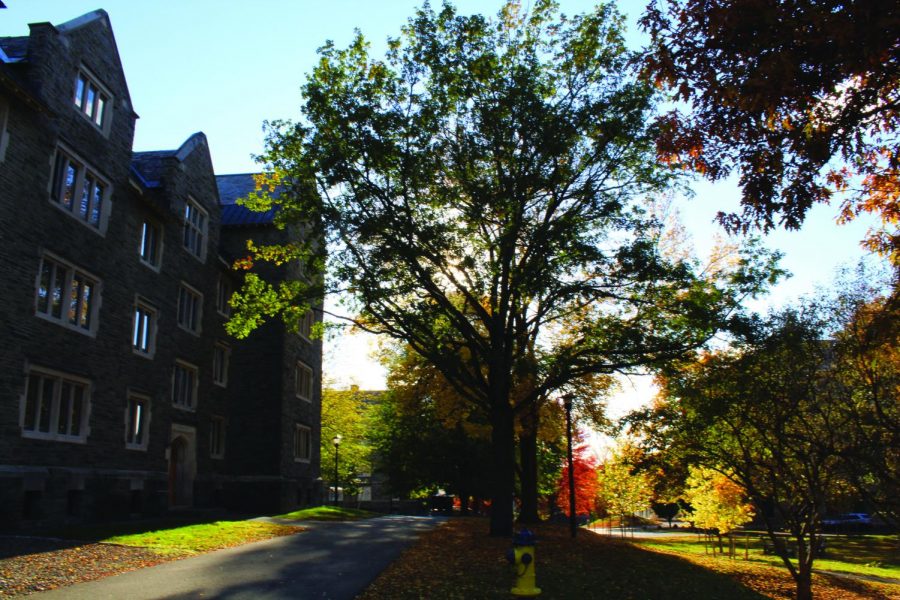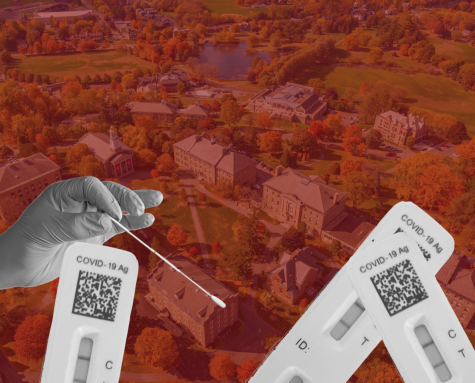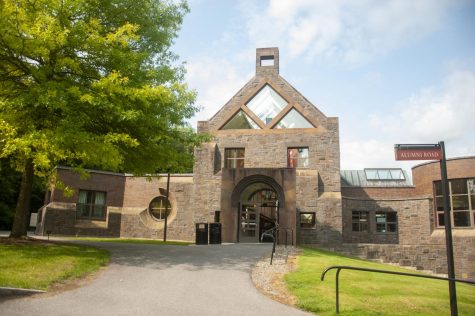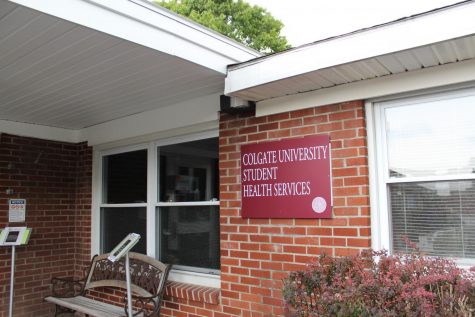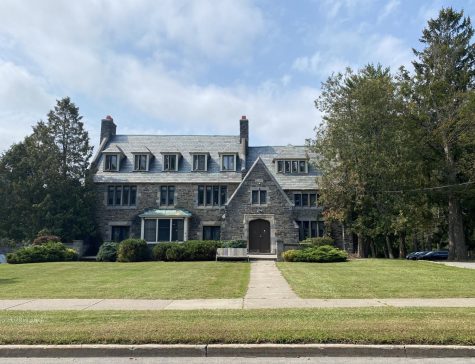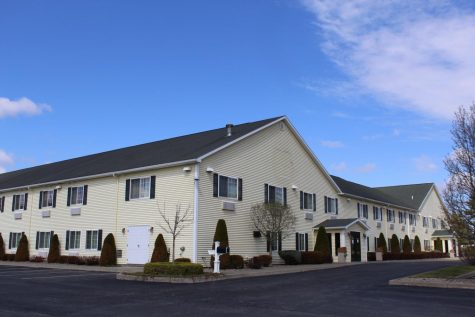Up-Hill Gatherings Cause Community Concern
Reports of large gatherings in violation of the Commitment to Community Health (Commitment) have raised concerns among the Colgate community, including students who say Upper Campus, where most first-years and sophomores live, has been a particularly problematic area. Students say that since entering Gate 1 following Colgate’s universal quarantine, large groups of students have gathered in the evenings on the residential quad and the fields between Burke Hall and Pinchin Hall. While multiple students criticize Campus Safety for allegedly failing to handle the behavior adequately, Campus Safety disputes these claims, saying they do take action in dispersing reported gatherings and that the rate of reported gatherings is decreasing.
Sophomores and residents of Burke Hall Ellie McDermott and Camille Boley say the gatherings are primarily groups of first-year students.
McDermott reported that multiple groups of over 20 students without proper social distancing and generally without masks congregate on the Upper Campus quads and sometimes the building lobbies, particularly on weekend nights.
“I see a lot of the gatherings in a lot of the different quad areas,” McDermott said. “I get it — I get why they want to hang out and stuff, but especially in the beginning… it was really frustrating because we all want to stay here.”
Boley added that the large groups she has witnessed have been first-year students.
“I know they’re [first-years] just because you tend to recognize people in your grade at this point,” Boley said. “They’re very loud, very late in the night and the groups are — I don’t even know how to guess how many they are because they just seem so large and so close together.”
Associate Vice President for Campus Safety, Emergency Management and Environmental Health and Safety Dan Gough said that while Campus Safety has received many reports of outdoor gatherings on Upper Campus throughout the semester, he hasn’t seen a significant difference between reports of gatherings up the hill and the rest of campus.
“[Students are gathering in] any area where you couldn’t go to someone else’s residence [prior to Gate 2], whether it was a residential hall room or a townhouse, or apartment, people gathered outside,” Gough said. “Which is actually, from an infection control standpoint, a good thing. It’s not good to do it if you’re not physically distanced, and that’s where the problem was, because people were not physically distancing.”
While McDermott and Boley acknowledged that they haven’t witnessed other areas on campus firsthand, they do see a significant difference between the conduct of the first-years and sophomores up the hill.
“I am up the hill so I don’t know how it’s going down the hill, but I do think [upperclassmen] seem to be pretty much gathering in small groups,” McDermott said. “I think because we all know what it’s like to get sent home early, and it’s not fun, we all don’t want that to happen again. But for [first-years], they don’t know differently than what’s going on right now… It’s just interesting because many of the older [students] are following a lot of the rules and then there’s just these blatant, giant gatherings.”
President Brian Casey said he’s aware of concerns about gatherings up the hill and working to facilitate safe, supervised outdoor activities for students on Upper Campus including bonfires and other nighttime events.
“I know it’s been a struggle that the first-year and sophomore culture of outdoor time [during Gate 0] created the [first-year] and [sophomore] culture of gathering outside,” Casey said. “I do know it’s been a cause for concern, so I do know the Dean of the College Division is just desperately trying to recognize the desire to be with each other, [so how] can we create safe venues?”
First-year and resident of East Hall Fiona* said that while she understands concerns about Commitment violations and the conduct of the first-years, she doesn’t see cause for immense concern if gatherings take place outside and most people wear masks.“As far as first-years not following the rules, I think that there definitely are some that don’t, but for the most part people are being pretty respectful of the rules. I think when it comes to masks, people usually wear [them]… I think the distancing is something we’re not quite as good at doing,” she said.
Gough said that Campus Safety officers were extensively trained and prepared to handle reports of gatherings and other Commitment violations when students arrived on campus. He explained they spent considerable time formulating the enforcement methods when officers responded to Commitment violations through the Bystander Intervention model.
“We chose to have a couple fundamental pillars for that approach, and it was to be educational and not enforcement-based to the greatest extent possible… and to be conversational, not confrontational-based to the greatest extent possible,” Gough said. “When we’ve responded to gatherings on the quads or fields, that’s been our approach — to be educational and not to be doing case reports on every instance. And what we said is only if we have to respond a second or third time and somebody is being intentional in their noncompliance [we will file a report].”
However, some students say they feel Campus Safety’s enforcement strategy is ineffective in discouraging students from violating Commitment regulations.
“If there was even just a fake threat, that would’ve been a little better. I just feel like people were not worried at all about Campus Safety coming and breaking things up,” McDermott said. “I have a view of the quad between Burke and Pinchin and sometimes I would see [Campus Safety] come break it up and they would also walk back together and take back off their masks. It didn’t seem like they were really enforcing anything or even threatening to enforce.”
Gough said he acknowledges criticism of Campus Safety’s enforcement style, but asserts that officers do split up gatherings they respond to, and come back multiple times to address violations when students regather.
“Some people have said ‘hey, you need to be more on the enforcement side.’ So, we’ve heard that, and every time my officers have responded they are breaking the groups up,” Gough said. “A lot of times what happens is as soon as they leave, everyone regathers, so there’s been multiple responses [and] it has the appearance that we’re not. That’s not the case.”
Casey stressed the difficulty in striking a balance between education and enforcement in response to violations.
“You always have to adopt the pedagogical educational [approach],” Casey said. “We’re a community, we’re a small place. But then there’s the enforcement. I felt like this has been an entire semester of trying to get that balance right,” Casey said
Gough said that, in his experience, many of the reported gatherings on Upper Campus seem to form unintentionally.
“When I watched at night what was happening, if three or four people were at a picnic table, another group of three or four students goes by [and] they just start talking — that’s human nature, we’re social,” Gough said. “No one intended to have a gathering in those cases but quickly became, literally in a minute, it could be 15 or 20.”
However, Boley disagrees with Gough’s assertion that most of the gatherings are fully unintentional.
“I think people have now, at this point, realized that people are always gonna be [on the Burke-Pinchin quad] if it’s a Friday or Saturday night. I feel like they’re probably not saying ‘oh let’s get a giant group out here,’ it’s more like ‘I know there’s gonna be a big group so I’m gonna join it,’” Boley said. “It’s a recurrence, so people just assume it’s gonna be there, so now people just show up. It seems like what’s a pre-scheduled party.”
Over recent weeks, Gough said the frequency of reports of gatherings up the hill have decreased, in line with a general campus-wide declining trend of reports, which he attributes in part to efforts to educate students on the rules of each Gate.
“The number of reported commitment to community health violations has decreased, and that includes reports of large gatherings, including on Upper Campus,” Gough said. “That’s not to say there’s still not pockets of noncompliance… I think people are just getting adjusted to the changing routine and infection control measures in place.”
Despite this general decreasing trend, as of Oct. 26, the Health Analytics Dashboard shows a low, but increasing alert of Commitment violations.
Fiona said while she’s seen less outdoor gathering recently, she’s worried that with the seasons changing and students turning to indoor spaces to gather and socialize, there could be an increased risk to the community.
“I would hope people will gather in smaller groups and I think in some ways they’ll be forced to just because there aren’t that many huge rooms,” she said. “Everybody definitely wants to get to know people and make friends and it’s hard because we don’t have a lot of opportunities to do that right now… sometimes it’s a difficult balance to choose between being completely safe and at the same time living your life.”
*All identifying details have been changed to preserve source anonymity.

Kirby Goodman is a senior from Minneapolis, Minnesota concentrating in peace and conflict studies with a minor in political science. She's previously served as...


